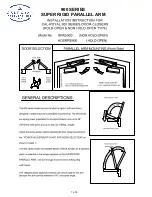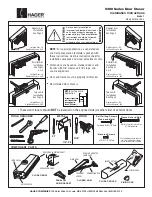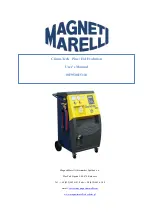
29
28
чѵс$)/*-.Ȃ /$)"*--*.$*))4./ (+ -!*-()
• “PH” or relative Acidity/ Alkalinity are of key importance in managing the production of system corrosion. It is
recommended that PH Level of the system water be between 7 and 8.5 (ideally 7.4/7.5). A Lower PH level than
recommended would be classed as acidic and corrode all metals. Alternatively, too high a PH level would be alkaline
and will corrode aluminium components within the wetted part of the system.
• When considering a chemical treatment product to add to the system, we recommend products which incorporate a
($3!*-0Ȃ -$)"Ѷ$)*- -/**)/-*'/# ' 1 '(*- Ȃ /$1 '4ѵ
• Oxygen Ingress should be minimised by the use of closed systems and barrier pipe within the system design.
•
""- ..$1 $*).җ.0#.ޕ03- .$0 .Ҙ+-*(*/ *--*.$*))Ѷ*)/$)0 /**.*0)' ..) 0/-'$. *-ޕ0.# *0/
completely. We would recommend a jointing approach that removes the need to use such compounds and adopt
the use of heat free systems.
•
!/-$/$*)'.*' -ޔ//$)".- 0. /# )2 2*0'- *(( )/# 0. *!- *")$. # ($'/- /( )//*ޕ0.#
out and neutralise the system (see section 3.1 below). In addition, it is strongly advised to contact the manufacturer
of the chemical treatment to gain early involvement prior to treatment as to the correct application and chemical to
use.
• The accumulation of sludge & debris can cause deposit corrosion which leads to pitting. We recommend the use
*!- *")$. # ($'/- /( )//*ޕ0.#*0/)) 0/-'$. /# .4./ ()$/$*)Ѷ$/$../-*)"'41$. /*
contact the manufacturer of the chemical treatment to gain early involvement prior to treatment as to the correct
application and chemical to use.
8.3 Refurbishment and Improvement to existing systems
• It is vitally important that before commencing works on existing systems that a complete scan of the water quality
of the system be taken. If it is found that the system contains products of corrosion and/or PH levels in excess
of the required norms, it is recommended that the existing water is conditioned and treated PRIOR to the work
commencing.
8.4 System commissioning (water quality) Water Treatment Chemicals
•
*)*/- *(( )/# 0. *!-22/ -!*-#4-0'$/ ./$)"0 /*/# -$.&*!*--*.$*)*!/# 2/ - $)"' ȅ$)
the system and potentially, the internals of the system being exposed to the air due to partial draining.
•
# ($''4*. 2/ -.#*0' $)''ޔ''$)"/$1$/$ .$)*-) 2$/#/# # ($'()0!/0- -.ҁ
recommendations and in accordance with BSRIA BG29 2012.
•
ȅ -.0$/' ޔ''$)")ޕ0.#$)"- "$( $.0. Ѷ- ' 1)//*/# .4./ ((/ -$'Ѷ''# ($'.0. /* .0$/'
for HIU must comply with EU norms DIN EN 12828 and current guidelines for heating systems. In addition, they
should also be non hazardous, non toxic and biodegradable.
• The use of correct cleaners and inhibitors is of primary, environmental concern. All chemicals used to treat the
system should not contain phosphates, sulphuric acid, nitrites. See BS7593:2006 Code of Practice for treatment of
water in domestic hot water space heating systems.
• Inhibitors should meet Buildcert as a minimum and preferably be recommended by the Energy Savings Trust (ESR).
• Acid based cleaners are unsuitable for older systems as there is a risk of “pinholing” on radiators. They will also
require some form of neutralisation process before being discharged or require being taken away for disposal.
8. Appendix A
8.5 Recommendations for system conditioning - (Basic process)
•
# .4./ ((0./ ޕ0.# )$)#$$/ $)*-) 2$/#цфшт)/# *( ./$0$'$)" -1$ .
Compliance Guide.
• The chemicals used should contain the following aspects of their composition:
–
Surfactants to reduce surface tension allowing chelating agents to attach to the residues.
–
Chelating agents will then entrap the calcium carbonate within the solution.
–
Dispersant’s are used to hold residues in suspension.
–
The inhibitor then prevents corrosive attacks on metals during cleaning.
–
0Ȃ -./*($)/$)) 0/-' ѵ
–
Chemicals shall be of a type suitable for disposal through a conventional sewer or foul drain (i.e. no requirement
for tankering or specialist disposal).
–
Neutralisation.
–
For cooling applications, specialist chemicals and advise should be sought.
8.6 Site installation conditions – Installation of the system
It is recommended that:
–
/ -.*'0' ޕ03.#*0' 0. җ)*#'*-$ Ҍ Ҙ/# - !*- ҂# /!- ҃.4./ (.- - *(( ) ѵ
–
The area of installation should be free from gypsum dust, brick dust, screed or other possible contaminants.
чѵц *(( ) ȅ -- җ Ҙ /2*-&-$(-4.$
• Any relevant details of the installed units and system conditioning to be documented in the O&M manual.
•
# - .#*0' ' -)*/$ޔ/$*)*!)4# ($'+-*0/. Ѷ/ . /+' *)/# ѵ
• If there is a requirement for a partial drain down, the inhibitor should be topped up to the required level with full
details.
•
#$"#'4- *(( )/#/''. -1$$)"ҝ$).+ /$*) /.+ -()0!/0- -ҁ.$)./-0/$*).җ Ѷޔ'/ -Ѷ# ($'. /Ҙ$.
fully adhered to.
• Any checklist sticker placed within the casing by the manufacturer must be completed.
8. Appendix A





































